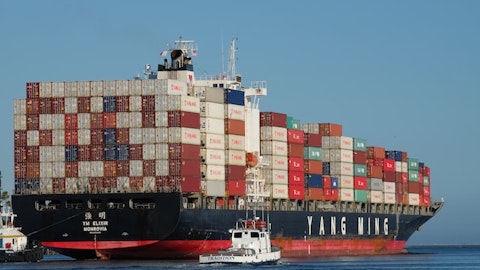ImmuCell Corporation (NASDAQ:ICCC) Q4 2022 Earnings Call Transcript February 22, 2023
Operator: Good morning, and welcome to ImmuCell Corporation Reports Fiscal Year 2022 Unaudited Financial Results Conference Call. All participants will be in a listen-only mode. After today’s presentation there will be an opportunity to ask questions. Please note that this event is being recorded today. I would now like to turn the conference over to Joe Diaz of Lytham Partners. Please go ahead.
Joe Diaz: Thank you. Good morning and welcome. As the operator indicated, my name is Joe Diaz with Lytham Partners. We are the Investor Relations consulting firm for ImmuCell. I thank all of you for joining us today to discuss the unaudited financial results for the year ended December 31, 2022. I would like to preface this discussion today with a caution regarding forward-looking statements. Listeners are reminded that statements made by management during the course of this call include forward-looking statements, which include any statement that refers to the future events or expected future results or predictions about the steps the company plans to take in the future. These statements are not guarantees of performance and are subject to risks and uncertainties that could cause actual results, outcome or events to differ materially from those discussed today.
Additional information regarding forward-looking statements and the risks and uncertainties that could impact future results, outcomes or events is available under the cautionary note regarding forward-looking statements or the safe harbor statement provided with last night’s press release, along with the company’s other periodic filings with the SEC. Information discussed on today’s call speaks only as of today, February 22, 2023. The company undertakes no obligation to update any information discussed on today’s call. Please note that references to certain non-GAAP financial measures may be made during today’s call. The company included definitions of these terms as well as reconciliations of these figures to the most comparable GAAP financial measures in last night’s press release in order to better assist you in understanding its financial performance.
With that said, let me turn the call over to Michael Brigham, President and CEO of ImmuCell Corporation, after which we will open the call for your questions. Michael?
Michael Brigham: Okay. Thanks, Joe, and good morning, everyone. Last night’s press release reports no change to our product sales results that were first reported on January 9. The press release also provides the full unaudited P&L results and some unaudited summary balance sheet data. We expect to file our full audited financial results on Form 10-K on or about March 29, 2023. I’m not going to spend much more time on this call discussing the financial results. I think it is more important to use this time to discuss the impact of a serious product contamination problem in our production process. We are going to take a hit in the first quarter of 2023. But we are working diligently to address the situation and believe we are taking the appropriate steps to emerge from this problem stronger with production capacity in place to produce more than $30 million of product per year going forward.
We disclosed this situation in detail in last night’s press release, but I’d like to recap the important points with you now. In 2018, it became clear that the demand for Tri-Shield First Defense was outpacing production. In response to this increasing demand, we began a series of investments during 2019 to increase our production capacity to over $30 million per year. The necessary facility expansions and new equipment to increase production capacity were in place by the end of 2022. thing is that, just as this increased production capacity that’s coming online, a production contamination event was detected by standard in-process quality control testing around the end of the third quarter of 2022. We took immediate steps to address the contamination and production ran without issue during the balance of the fourth quarter of 2022.
What makes matters even more challenging is that during the first quarter of 2023 our standard in-process quality control testing has affected a second contamination event. This is resulting in a slowdown in production output as we take the necessary steps to assess and remediate the issues and ensure that we — that any product that has put to market meets all quality standards. We believe that the ongoing implementation of our capacity expansion plans and the corrective actions being taken in response to these contamination events should allow us to operate at a higher level of production output going forward without further significant contaminations. The slowdown in first quarter production output has, in part, contributed to a more than doubling of the order backlog since the end of 2022.
We expect to report reduced sales during the first quarter of 2023 and a large increased backlog as of March 31, 2023. Due to the loss in earned gross margin as being incurred during the first quarter of 2023, we have made the decision to defer for the time being, completion of the incremental plan investments and increase our production capacity further to over $40 million per year. The increase in sales demand for First Defense is both exciting and difficult for us. At the same time, we are preparing all the data required to make our third submission of the CMC technical section, the approval of which by the FDA is required to market Re-Tain. The submission will be subject to a six month review by the FDA. We aim to resubmit during the first quarter of 2023, subject to completion of several critical path items that require results from external laboratories.
So by way of conclusion and to be very direct, one view is that we have driven the company the backlog and contamination on the First Defense side while not yet achieving FDA approval of Re-Tain. However, the other view is that we are approaching both $30 million in annual production capacity for First Defense with a flex auction to get to more than $40 million in the future, while at the same time, we were advancing to the final stages of a very significant FDA product development initiative. I take the latter view as I work to attract, retain and motivate our greatest assets, that being the employees that are working so diligently to make all this possible. Lastly, I encourage you to review the press release that we filed last night. Also, please have a look at our corporate presentation slide deck.
I believe it provides a very good summary of our business strategy and objectives as well as our current financial results. A February update was just posted to our website last night to the Investors section of our website and click on Corporate Presentation or Contact Us for a copy. We expect to disclose more information about the impact of the product contamination and the updated status of our remediation efforts in our annual report on Form 10-K on or about March 29, 2023. With that said, I will be happy to take your questions. Let’s have the operator open up the lines.
Q&A Session
Follow Immucell Corp (NASDAQ:ICCC)
Follow Immucell Corp (NASDAQ:ICCC)
Operator: We will now begin the question-and-answer session. And our first question here will come from (ph) with SMI.
Unidentified Participant: Hi, Michael. How are you today?
Michael Brigham: Hi, Charles. Good morning. I’m doing all right. Thank you. How are you?
Unidentified Participant: All right. We are doing good. Just walked outside this morning, we got eight inches of snow and that’s to the call hear. Michael, I just had a couple of quick questions. I didn’t see a big charge-off on the operations statement due to the contamination, in other words, a line item. Were you able to salvage any of those batches or were they a total loss?
Michael Brigham: Yes, that’s a good question, Charles. A little tricky. So third quarter, as I mentioned, two events. That third quarter event, of course, is reflected in the 2022 results, and we’ll detail that in the K with the cost of goods discussion in the MD&A. So — and then we’re still evaluating this first quarter, but you’re right. It’s not all a write-off. I think the immediate impact is timing. So it does slow — as I momentum, it slows down production, some of that product can be successfully reworked and some of it will become a write-off. And that is all under careful evaluation. That’s what I was referring to. I think we’ll have better data to assess that or report that in a couple of weeks here with the three or four weeks for the 10-K. But you’re right, it’s two things. Some of it can be salvaged, reworked. Some of it will be a P&L write-off.
Unidentified Participant: Okay. And in your deferred investment, I would assume that, that’s for preservation of capital reasons. Would that be correct?
Michael Brigham: Yes. That project was largely funded by sales, by gross margin.
Unidentified Participant: By profit, yes.
Michael Brigham: By profit. So we’ve taken a cautious approach. It’s not immediately needed with sales being around $20 million, with our current capacity being about $30 million. The objective was to get ahead these investments as you see and take some time in a number of years. So we want to get ahead and get to that $40 million level, but I think it’s prudent cash flow-wise and safe production wise to pause on that, settle, get back up and running at the $30 million and — I still intend to put that program back in place, but it’s not — the start date is not that urgent.
Unidentified Participant: Okay. And then the — do you have any idea of what the attrition rate is on the backlog? Do you guys lose a lot of that backlog to other products or are those backlogs, did most of those come to fruition?
Michael Brigham: That’s another great question, Charles. Our sales team works so hard on that answer every day. I mentioned the doubling of the backlog. Some of that — a lot of that happened even before the contamination related slowdown, so demand is really strong, and the orders continue real strong, but we do know that these calves are born and a lot of these customers will go find an alternative product. So we’ll lose some and the challenge is to bring our supply and go get them back and just to sell our efficacy. In my opinion, they’re going to move to a product that’s not as effective. That’s why our orders are so strong. They want First Defense. So bring in supply and the sales team has a huge challenge with the balance of the year. We’ll find those that switched over to something else and bring them back.
Unidentified Participant: Well, I know you’ve got a great product. So if you’ve got a good sales team, they’ll get it back for you. I have another question. When you go to raise the funds that you’ve deferred, what method do — what methods do you look at to raise those funds? Is it loans? Or is it to sell more stock? And if you do sell more stock, is that dilutional? If you could just talk about that for a second. And that would be in the future, obviously, with what you had said.
Michael Brigham: Yes. If I could just go back for a second. I appreciate your confidence in the efficacy of our product, and you said if you have a good sales team, and I would just add, our sales team is uniquely positioned to bring this back to get these lost customers to regain the sales that works so hard and suffered so long through this backlog is going to be a joy to have an selling with inventory on hand. But then as to financing, your question there, yes, my first objective is gross margin. That’s the best way to fund this business. We’ve done a lot of equity. We’ve done a fair amount of debt. But in a situation like this, we’re going to keep our eyes open, be flexible to all three, what’s the best way to make up for this first quarter loss and a loss is still being evaluated. So I would say it’s only prudent to have all options on the table.
Unidentified Participant: Yes, it’s a premature question. I’m sorry about that. When you’re coming out with your Re-Tain product, hopefully, in 2024 or late 2023. We don’t know. So no point in speculating on that. Is the Re-Tain going to be made in the same factory or lab? I don’t know your terminology — but place as your First Defense? Or — and then if it is, do we have to worry about contamination issues crossing over from one product to the next?
Michael Brigham: Charles, that was another great question.
Unidentified Participant: I’m sorry, these are tough questions but
Michael Brigham: No, no, no, it’s just spot on. They are hood questions. I appreciate it. So let me just first comment on the timing. Just to be clear, this submission that goes in, again, will be subject to a six month review. And then there’s a two months, let’s call them administrative review at the end. So I just look at it as eight months from submission. But you’re right, that’s what we control, the submission, and then the review and the approval is in the FDA’s hands. So we will have that news complete or incomplete eight months from submission. But no, to production, it’s a very fair caution, but it’s a completely different facility. It’s a short walk out of our back door. It’s still different standards as far as air control and separation of process, it’s FDA regulated as opposed to USDA.
I would say this remediation process in part is taking some lessons from the Re-Tain facility, not all of which can be implemented into the USDA facility. But it is a very different facility, very different inspection standards and we have no crossover at all of product or equipment and very little crossover of even people. So same company, but a little bit of a different world over there at, what we call 33 for Re-Tain.
Unidentified Participant: Yes. Thank you very much for I learned something today about the difference between USDA and the FDA, just I wasn’t thinking about that. So thanks for opening up that horizon for me.
Michael Brigham: I think when you look at the development budgets and I talk about capacity expansion for First Defense compared to the investment we’re putting into Re-Tain, it comes at a price. That Re-Tain facility cost us $20 million. We’ve invested just $5-ish million to get to this $30 million on First Defense. So yes, it is different. But we move to one quality fits all.
Unidentified Participant: Now we’ve got a lot of confidence in you, Michael. So I hope that things continue on. One more question for you, and then I’m finished. I’m sorry to take up too much of your time here, but where do you see ImmuCell going in in, let’s say, the 2024 or 2025, what’s — can you just give a quick thumbnail sketch of kind of what your vision is for these next two years?
Michael Brigham: Right. It’s pretty clear, and it hasn’t changed except that one real significant surprise challenge put right on top of us. So the goal precontamination remains the same post contamination, which was 2023 was a great year of transition, a great year of milestone achievements, huge catalysts being, number one, $30 million capacity. The ability to grow sales, $10 million on top of the current $20 million, just on the doorsteps of having that, we get the setback on contamination. So we work with sort of the new — the new twist is same for the First Defense, but remediate the contamination. And then the other thing that just hit the same year, 2023, when I say it’s a year of two big catalysts, the second was this FDA reading, seeing that.
And so the goal is always just get out the backlog, produce more First Defense and give the FDA another opportunity to say yes. So as we turn to the second year in your question, 2024, we’re much more commercial focused, much less product development and just selling a bunch of First Defense and initiating what we call that controlled launch, that market introduction of Re-Tain to the industry.
Unidentified Participant: Yes. It sounds like with all your hard work, we need a little bit of luck to bless us on this thing.
Michael Brigham: It does take — I do believe — I think its skills on the First Defense side and just hard work and I think on the FDA side, you do need a little bit of luck. .
Unidentified Participant: Yeah. There is no question. All right, Michael, you have done a fine job for me and I want to thank you for your time and really good luck with these impending challenges lying in front of you.
Michael Brigham: That’s great, Charles. And I appreciate the chat. And we will keep the communications very current.
Unidentified Participant: Okay. Thank you, sir.
Operator: Our next question will come from Frank Gaster, a Private Investor. Please go ahead.
Unidentified Participant: Mike, thanks for taking the call.
Michael Brigham: Yes, thank you.
Unidentified Participant: A question on Re-Tain. I believe one of the press releases is about the last submission had to do with facilities inspection. Has that been redone — the inspection?
Michael Brigham: Right. That’s a good question as well. The inspection will take place sometime after the submission, it will take place during that — well, I should say we suspect, but we’re highly confident it will take place during that six month review period. So essentially, I think the FDA takes a position of — we’re not going to mobilize our inspection team until you guys are serious. Now the submission is pending and under our review. So that is still ahead of us.
Unidentified Participant: Okay. It seems like a kind of odd way to go about it, where you under the prospects of having the simple inspection dictate release?
Michael Brigham: I know. It’s a tough — it’s a really tough process, but I should clarify, they did make their first inspection. They issued their — essentially, to-do list. And then as we communicated with them, that’s what we learned. Okay, look, we’re going to wait. When you make that submission, one of the items on the to-do list with that submission was to tell them that we’re ready for inspection. So I just think they’re busy, and I think they took the attitude, we can get it done within six months, let’s not bother unless they’re serious enough to have made that final CMC submission.
Unidentified Participant: All right. And another question on Re-Tain. I was understanding that — or rather, can you explain or give some color in regards to your comments about the critical path and lab — or some lab results from third-party?
Michael Brigham: Yes. I mean essentially, what the FDA required is to have certain analysis, certain testing procedures done by two labs. So we’ve been able to control the method and completion, the process on our hands, but they want it to be robust enough that someone else can do it. So that is the — that’s the critical path item to have that repetition done outside of ImmuCell.
Unidentified Participant: And you’re still going with the Q1 submission time frame?
Michael Brigham: Yes, we are. We all are. We know how important that is, it’s going to be very close. I don’t think — we’re already here towards the end of February. But it’s hard when I put out those projections, they move a little bit because the reality changes our best ambitions, but I do feel very confident that we’re down to a matter of days, not a matter of months from that target. And everyone in the project is expecting still to make this in March.
Unidentified Participant: Okay. And one more. Could you give me some idea about the SG&A line? It seems to be significantly higher than a year ago.
Michael Brigham: Yes. Of course, I get that detail because I think as you noted, the press release kind of aggregates, but the selling line is — I’m sorry. I’m not to say the administrative line is very steady, pretty inflationary. It doesn’t move more than the $100,000 or $200,000. We have made a conscious decision to increase that selling expense and that one is more triggered by controlled or budgeted by a percentage of sales. So it has increased with a couple of really important personnel hires and also some really good programs. There’s some really critical and very important to the to the rebound here from the backlog having Dr. and the team, providing Tecipar, having Mark Listenberg. I mean he came in for Re-Tain with 30 years of cheese experience and having him be part of the team to remediate our contamination problems.
It’s hugely valuable. So the sales team has grown and the sales programs have grown and it’s proportional to sales. We always keep it under 20%. But yes, we’ll bump there in 2022 on the sales expense side, and it’s smaller bump on the admin side, and I’ll get you that detail here in the K.
Unidentified Participant: Okay. That’s all I had, Mike. And I’m looking forward to a potential for First Defense come to fruition. It’s been a long time
Operator: This will conclude our question-and-answer session. I’d like to turn the conference back over to Joe Diaz for closing remarks.
Joe Diaz: I’d like to thank all of you for participating on today’s call. We look forward to talking with you again to review the results for first quarter of 2023, on or about May 16, 2023. Have a great day.
Operator: The conference has now concluded. Thank you very much for attending today’s presentation. You may now disconnect your lines.




